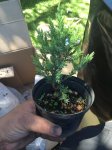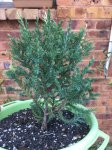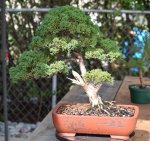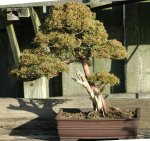Dorian Fourie
Chumono
I received a Juniper seedling in Nov 2015 and was told that it Sargent Juniper Variegated Seedling. (It could be wrong)
Over the last year I have left it to grow and it is coming along nicely. My end goal for the tree is a formal upright as per the image below that I found on the net.
This is a Blaauw Juniper by Wally Kunimoto taken in 2011 and what I would like to achieve.

This is the seedling as I got it in Nov 2011

This is the seedling now.

Can anybody advise me on the growing habits of this tree or give me a very good website on pruning tips etc to be able to achieve my goal
Thanks
Over the last year I have left it to grow and it is coming along nicely. My end goal for the tree is a formal upright as per the image below that I found on the net.
This is a Blaauw Juniper by Wally Kunimoto taken in 2011 and what I would like to achieve.

This is the seedling as I got it in Nov 2011

This is the seedling now.

Can anybody advise me on the growing habits of this tree or give me a very good website on pruning tips etc to be able to achieve my goal
Thanks




